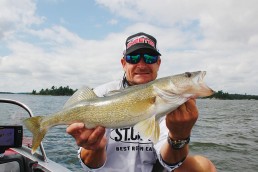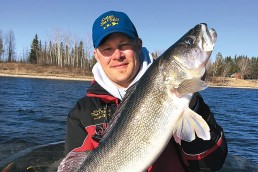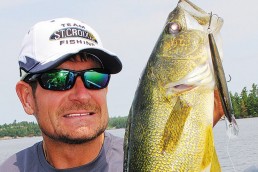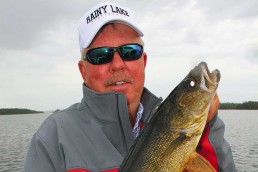Rainy Lake’s Walleyes: Spring, Summer and Fall
Along with another much larger Minnesota-Ontario border lake to the west, Rainy Lake rarely experiences the “summer blues,” a timeframe when walleyes in some bodies of water become sluggish feeders and can be difficult to catch in July and August.
This contrast can be traced in many respects to the trophic states of different water systems. Mesotrophic or eutrophic lakes with higher levels of fertility can be more inconsistent in summer when the highest water temperatures of the year trigger algae blooms. Most of our best Midwest walleyes fisheries are classified as “mesotrophic.” The water column in mesotrophic lakes tend to stratify in summer, meaning a distinct layer forms between the warmer algae-laden surface layer and the clear-water deep zone. Since stratified water columns don’t mix well, the deeper regions of the lake become oxygen-poor as decaying plant matter and zooplankton (and dead fish) sink to the bottom to decompose. Walleyes and other species then have to move shallow to survive.
As we travel farther north, we encounter more oligotrophic waterways like Rainy Lake, systems generally characterized by less fertility with fewer nutrients, aquatic vegetation and the phenomenon of algae blooms, and deeper water in the main-lake basins and colder water temperatures. And while you’ll still find mid- to high 70s in the shallows for the kids’ swimming on summer vacation, the deeper regions of Rainy Lake will remain colder and clearer with highly oxygenated water. This is a key distinction since colder water contains more dissolved oxygen. Oligotrophic systems contain high levels of oxygen throughout the lake, as compared to more southern bodies of water where higher water temperatures, heavy vegetation and algae blooms tend to thrive.
In a walleye fishery like Rainy, the bite can remain consistent from shallow to deep water, from spring into fall. This provides an inherent benefit to anglers as many can apply a favorite fishing tactic to walleyes in Rainy Lake and catch many.
If you troll crankbaits, you’ll find easy fishing in northern Minnesota lakes like Rainy during the spring and fall. But only in summer, when the highest water temperatures of the year push walleyes deeper, is when trolling a lure along the scenic shorelines is unproductive. Walleyes typically don’t suspend very often at catchable depths on Rainy Lake, unlike in some other systems.
Trolling cranks for walleyes works well for covering more water and contacting active fish, and can provide a trigger for negative fish by causing a slashing reaction strike as the lure wobbles past. Perhaps, after several passes along a particular stretch of shoreline or back and forth across a tapering underwater point, you’ll determine enough fish are present for you to slow down and focus on the school with other methods. Contour trolling is easiest, and done simply following the shoreline breaks, imparting slight S-turns and varying depth. Applying lures with different dive curves can also help you target different depths.
On Rainy Lake you won’t need inline planer boards, leadcore, line-counters or overly complicated gear. Simply choose a favorite lineup of cranks—one per angler—and let out some line, stagger the depths to avoid tangles (deeper lures down the middle, shallower options to the outsides) and troll the rocky shorelines. The LakeMaster Woods/Rainy GPS chip provides detailed, 1-foot lake bottom contours for you to follow.
Casting crankbaits and jerkbaits is another effective method for walleyes, especially in spring or when windy conditions push the fish shallower to feed. With the vast majority of Rainy’s shoreline dominated by rock structure, you’ll find endless choices as far as key locations throughout this lake. Focus on areas where the drop-off from shore is not severe, or too vertical. You’re much more likely to find fish on more gradual breaklines and underwater points where gravel, rubble and boulders comprise the primary bottom content. This structure holds more baitfish and crayfish on which these walleyes feed. I use the Shallow Water Highlight feature on my Humminbird to pinpoint areas that congregate fish. If the highlighted depth I prefer appears as a “narrow band” on the map, I avoid it. Focus on spots where the shallow highlight appears as a “wide spot” along a shoreline, a tapering point, or perhaps an isolated reef that juts up not far from shore.
The most popular walleye-catching tactic on Rainy Lake in midsummer through fall involves live-bait fishing atop the main-lake reefs. Again, use a GPS chip to pinpoint these locations and find where rubble humps rise from the deep basin and top out usually in 25 to 40 feet. A jig-n-minnow combo is ideally suited for this type of fishing, with the boat positioned vertically above fish after you mark your electronics. Hover in place and creep around the structure to stay on a hot bite.
For live-bait rigging, employing either a slip-sinker rig or bottom-bouncer to produces numbers, especially if the walleyes are showing a preference for nightcrawlers or leeches rather than a jig/minnow presentation.
Spring, summer and fall fishing for walleyes on Rainy Lake is as good as it gets in Minnesota. The lake is consistently ranked as producing one of the highest catch rates for anglers based on MNDNR surveys. The fishing can be easy, and always is fun. Rainy offers some of the biggest average-sized walleyes in the state too. If you’re looking for a super spot to go fishing with family and friends this summer, Rainy Lake is a great choice.
MWO
SHARE THIS POST
Did you enjoy this post?
You can be among the first to get the latest info on where to go, what to use and how to use it!



